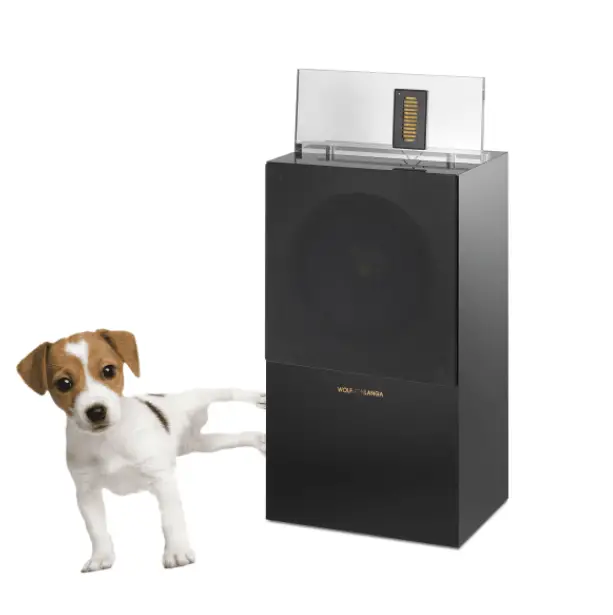Dogs are famous for having excellent senses, particularly those of smell and hearing. Dogs have better hearing than humans, so they can obviously hear the music we play.
Even though pups are born deaf, they start developing hearing skills around the age of three weeks. In comparison, humans have only six muscles that track the movement of their ears. This explains why they have such good hearing and their ears’ responsiveness and sensitivity.
Dogs are very receptive to music, even though they don’t understand what these sounds are! Just like us, Dogs can also hear music when we play it on Subwoofers or other sound systems, and they can probably pinpoint your Subwoofers as the source.
Can Dogs Hear Subwoofers?
When we are exposed to loud noises, we choose to leave the room or even plug our ears to protect them. Unfortunately, dogs cannot do so. Before we start, it’s worth noting that the audio spectrum spans 20 Hz to 20,000 Hz. As you can see, this is within a human’s range.
Dogs have a wider hearing range than humans, particularly at higher frequencies. However, they may be unable to hear subwoofer bass, which typically ranges from 20 to 60 Hz.
Subwoofer bass is the first usable low frequency in most musical recordings and is often felt more than heard. The next thing is the most broad-spectrum of bass, and these signals typically range from 90 to 200 Hz, which is well within your dog’s hearing range.
Signs That Your Dog Can Hear Music Through Subwoofers
As you know, dogs have excellent hearing, but how do you know? If you spend any time with a dog, you will quickly understand how good their hearing is and how important it is in their lives.
They use their hearing, along with their sense of smell, to determine whether someone is a friend or enemy, as well as to pick up on your emotional responses and mood. If you enjoy music and play it around your dog, you’ve probably noticed them reacting in some way.
This is due to the fact that dogs can hear music through subwoofers. Dogs can hear much higher pitches than humans, so they often react strongly to ambulances and other loud sounds.
When it comes to music, dogs are aware that something is coming from the Subwoofers and will likely look to you for guidance on how to react.
There are a few ways of telling if your dog is listening to music coming from your home or car subwoofers; all you have to do is observe their behavior. Examine their ears to see if they are moving back and forth, alert, or relaxed. This is an excellent indication that they are paying attention.
Signs Your Dog Can Hear Subwoofer Bass
Dogs can hear much better than humans can. That’s why they mostly perk up at something before you even notice it’s there. When it comes to music, especially bass, dogs are quite responsive. They give a proper response when they hear something with full bass.
Many experts think that dogs with large, aroused ears can hear frequencies up to 75,000 Hz, which explains why they frequently react to noises that are far beyond our hearing range.
As demonstrated by the comparison of a dog’s hearing to ours, they have a far higher ability to hear high-pitched sounds than low-pitched ones.
They can also detect sounds that we cannot hear in daily life, such as certain noises on television and noises from common home appliances.
Each dog is distinctive, but there are some common behaviors your dog will exhibit when exposed to low bass. If the noise is too loud, you may observe their ears moving independently of each other, switching back and forth, or even lying down on their head.
Bass often carries deep vibrations that we can feel in our bodies, and your furry best friend is no exception. They also feel the same.
Body Language Of Dogs When They Hear Music Through Subwoofers
Indications that your dog is hearing music from the Subwoofers:
- Alert Barking
- Ears up
- Back hair on the cutting edge
Other Indications
- They are watching you see how you react.
- They inspect the Subwoofers.
- Their ears are moving in all directions.
- Searching for the source of the noise
Is Loud Music Produced By Subwoofers Harmful To Dogs?
Like humans, dogs can also suffer from hearing problems if they are exposed to loud noises such as music for an extended period of time. According to a study published in the journal Topics in Companion Animal Medicine, loud noises can harm the delicate structures in a dog’s inner and middle ear.
According to Dr. Kari Foss, Noise-induced hearing is typically caused by “damage to the hair cells in the cochlea that vibrate in response to sound waves.” Furthermore, extremely loud noise may “affect the eardrum and the cranial bones within the inner ear known as the ossicles.”
Though it is difficult to determine how loud is too loud, dog owners can research different decibel levels. When a dog barks, the decibel level is at least 60.
A normal conversation is approximately 60 decibels, a lawnmower approximately 90 decibels, and a rock concert approximately 120 decibels. Sounds above 85 decibels are generally harmful, depending on how long you are exposed to them and whether you have ear protection.
Tips For Staying Safe When Your Dog Hears Music Through The Subwoofers
- Make sure the volume isn’t too loud.
- Turn off the music or take them to the next room if they seem bothered by it.
- Consider puppy earplugs or muffs.
- Avoid subjecting your dog to loud noises on a regular basis.
- Take note of their actions.
How To Determine Whether The Subwoofer Music Is Too Loud For Dogs
Dogs have much better hearing than humans. They can sense sounds four times more far away than humans can and frequency range that humans cannot hear. It might not be a big issue for you when you hear loud noises, but it may sound much louder to them when your dog listens.
If your dog doesn’t like loud music, he may start to show certain anxious behaviors. Like, He could flee by running away or trying to hide under a bed or blanket. He could also bark, start whining, or pee in inappropriate places.
You could listen to music at a low volume, go to another room, place your dog in a different location, or put on your earphones to ensure your dog’s comfort. If you’re driving, you can adjust the music so that you only hear it upfront – though you should still keep it at a low volume.
Dog’s Hearing Loss Symptoms
If your dog already has lost some hearing due to exposure to loud music or other loud noises, he may not reply back when you call his name.
Perhaps he no longer reacts to noises, or he makes strange vocal sounds or barks all the time. If you believe your dog has lost some of his hearing, you should take him to the vet right away.
A dog with hearing loss is extremely dangerous because he may not hear a car coming down the street or notice other types of threats that could harm him.
FAQs
Do Subwoofers Cause Ear Damage In Dogs?
If you are thinking about teaching your dog to respond to certain noises, such as bass, it is critical that you never do anything that might damage their ears. Most dogs cannot hear low bass, but they can hear pitches much higher than we can imagine.
Do Dogs Dislike Loud Music?
Dogs are more sensitive. They can distinguish sounds as low as -15 decibels. As a result, you should take the same precautionary measures with your dog’s hearing as you would with your own! Most dogs are naturally afraid of loud noises.
Is Loud Music Bothersome To Dogs?
Dogs have even more sensitive hearing than humans and can be bothered by noises that we don’t notice and sometimes noises we can’t even hear. However, as long as the music isn’t too loud, dogs used to loud music don’t seem bothered by it.
Conclusion:
Your dog has a natural sense of hearing, which includes hearing new sounds and noises in the wild as well as in your home via your subwoofers.
They can hear well beyond our hearing range. Dogs do not have the same neurons that we do for music interpretation. So, while they can hear sounds coming from your subwoofers, they do not have the same ear as you.
Loud music may be harmful to your dog, so listen to it at a low volume or wear headphones when your dog is present. If your dog is exhibiting anxious behaviors, you must find a way to eliminate the noise. In addition, if your dog appears to be deaf, you should take him to the vet for checking.



